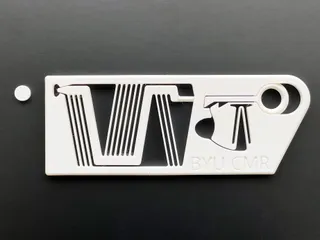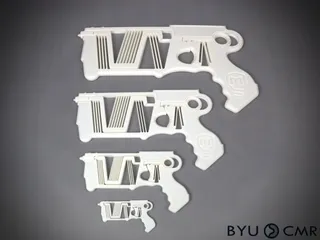Volume-Efficient Miura-ori (VEMO) with windows
Description
PDFSummary
The Volume-Efficient Miura-ori method was developed as framework for ultra-compact deployable reflectarray antennas for CubeSats.
The method modifies the Miura-ori pattern by introducing degree-6 vertices at the minor ends. This results in parallelogram unit cells through the body of the array, and three-quarter and quarter cells at the minor ends of the array. For thickness accommodation, the offset-panel hinge-shift technique is applied to the unit cells and the hinge-shift technique to the three-quarter and quarter cells (see link below).
A similar design with electromagnetic simulations can be found here:
This particular design is a 5-by-3 VEMO with a structural thickness of 6.4 mm (just over 1/4 in) and accommodates for 0.15mm-thick membrane hinges.
The hinges are made from the spinnaker tape linked here.
Hinges are reinforced by taping in the stowed then deployed states. 5-inch strips were cut and twice bisected with a guillotine trimmer to simplify the taping process.
Learn More
This design was developed by the Compliant Mechanisms Research Group (CMR) from Brigham Young University (BYU). Follow us at @byucmr on Instagram or visit the BYU Compliant Mechanisms Research (CMR) website to learn more about compliant mechanisms.
See https://rdcu.be/dnHx0 for an article in Nature Communications about how and why we share these maker resources.
Technical Information
For in-depth technical information, see the following publications:
Pruett, H. T., Kaddour, A. S., Georgakopoulos, S. V., Howell, L. L., & Magleby, S. P. (2022). Optimizing geometry for EM performance to design volume-efficient Miura-ori for reflectarray antennas. Extreme Mechanics Letters, 56, 101889.
Rubio, A. J., Kaddour, A. S., Pruett, H. T., Howell, L. L., Magleby, S. P., & Georgakopoulos, S. V. (2022, July). Volume-Efficient Miura-Ori Reflectarray Antenna for SmallSat Applications. In 2022 IEEE International Symposium on Antennas and Propagation and USNC-URSI Radio Science Meeting (AP-S/URSI) (pp. 169-170). IEEE.
To learn more about compliant mechanisms in general, see the BYU Compliant Mechanisms Research (CMR) website or these books: Compliant Mechanisms, Handbook of Compliant Mechanisms.
Intellectual Property
The downloadable 3D print files provided here may be used, modified, and enjoyed for noncommercial use. To license this technology for commercial applications, contact:
BYU Technology Transfer Office
3760 Harold B. Lee Library
Brigham Young University
Provo, UT 84602
Phone: (801) 422-6266
https://techtransfer.byu.edu/contact
Tags
Model origin
The author marked this model as their own original creation.




